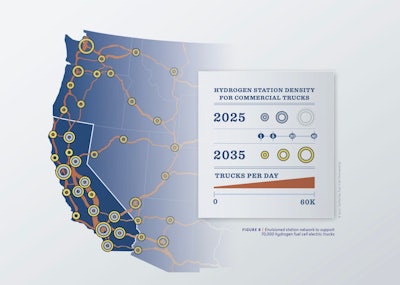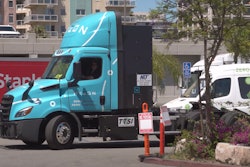Hydrogen internal combustion and fuel cell powertrains show real promise in helping fleets to slash emissions while providing the power, quick refueling and lighter GVWR needed to move heavy loads beyond the limits of battery-powered trucks.
However, as Commercial Carrier Journal learned recently at the Advanced Clean Transportation Expo, fleets continue to express concern about gaining access to hydrogen particularly if they reside outside of California, which is ground zero for the growing zero-emission fuel cell truck segment. (While impressive with near-zero emissions, hydrogen internal combustion hasn’t reached zero emissions, a critical goal for California and other states that champion the nation’s most aggressive goals for cutting and eventually eliminating emissions in the transportation sector).
A U.S. Department of Energy map currently shows only 48 hydrogen (H2) fueling stations in the U.S. and five in Canada. All 48 stations in the U.S. are confined to California, home to the nation’s busiest ports and busiest trucking hubs.
Sizing up H2 station development within the Golden State is fairly easy. Type in a few key words and the web responds with a tsunami of information. Most notably, the California Energy Commission announced in December 2020 a plan to add an additional 111 hydrogen stations in the state by 2027 to support passenger cars, trucks and buses. By 2025, California anticipates having up to 200 stations to support fuel-cell vehicles, a 317% jump from its four dozen stations.
 Counting on Class 8 trucks. Here's what a hydrogen station deployment could look like in 2025 and 2035 according to the California Fuel Cell Partnership. California Fuel Cell Partnership
Counting on Class 8 trucks. Here's what a hydrogen station deployment could look like in 2025 and 2035 according to the California Fuel Cell Partnership. California Fuel Cell Partnership
“As the market expands, hydrogen fueling stations will be matched with vehicle rollout as both grow together,” the DOE states on its website. “Customers are expected to have similar experiences at hydrogen fueling stations as at gasoline stations, with most hydrogen dispensers being added at existing gasoline stations.”
Shell, currently the top player in H2 station development for trucks in the U.S., won’t say much about their future plans. The global energy giant recently made headlines following a strategic station roll-out in Southern California.









